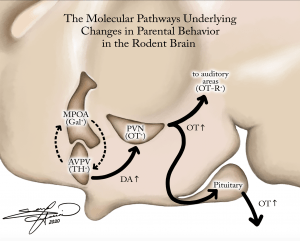-
The rodent brain serves as a model for the molecular pathways underlying the changes seen in parental behavior, upon visual and tactile stimulation from offspring. Visual and tactile cues from rodent pups first stimulate the anteroventral periventricular nucleus (AVPV), which releases tyrosine hydroxylase to the medial preoptic area (MPOA). The MPOA then releases the neuropeptide galanin in a loop back to the AVPV. The AVPV also then communicates forward via increased secretion of dopamine (DA) to the paraventricular nucleus (PVN). The PVN then increases oxytocin (OT) secretion and sends signals to both the auditory areas in the upper cortex, as well as the pituitary gland. The pituitary gland then also increases OT levels and delivers this hormone throughout the endocrine system to the rest of the body, to induce social-bonding and parental behaviors.
-
Scientific experimentation found that when rat pups signaled to adult female rat the adult female rat increased maternal care and increased oxytocin release. When pup signaling occurred in the presence of an adult male rat, the adult male rat decreased their aggression and therefore became less likely to attack the rat pups.
Viola Yu
Digital Illustration

